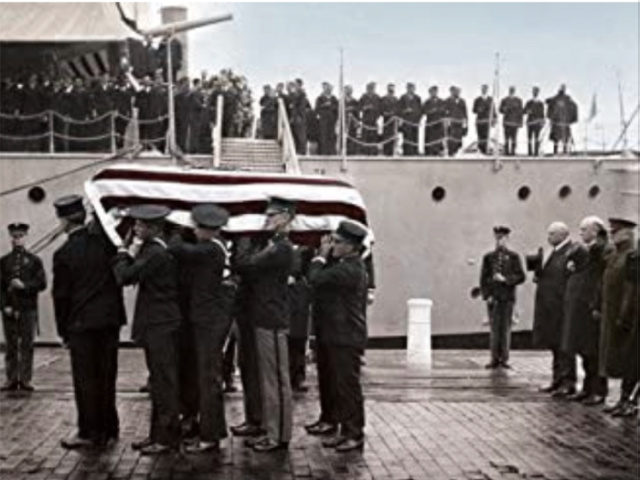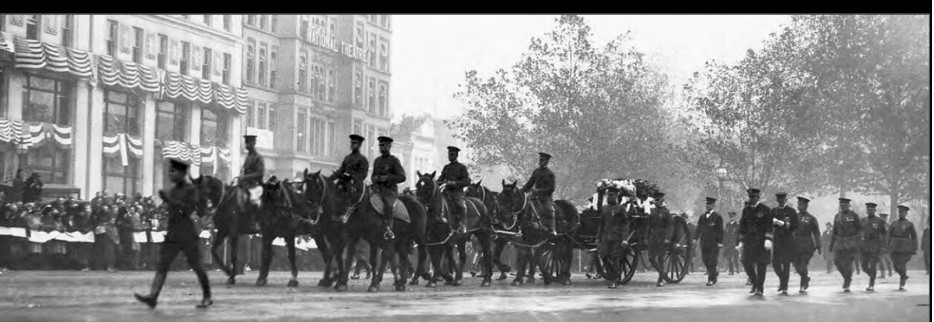This week, small towns and big cities all across the country will hold parades and other celebrations in honor of their veterans. One of the most poignant and meaningful of these ceremonies will take place at the Tomb of the Unknown Soldier in Arlington National Cemetery. During this year’s Veteran’s Day memorial celebration, Arlington Cemetery will recreate a portion of the ceremony that took place 100 years ago.
Every year, thousands of Americans gather at the tomb in solemn recognition of the tremendous debt we owe to our servicemen and women. There, at the eleventh hour of the eleventh day of the eleventh month, the annual wreath-laying ceremony takes place on the exact anniversary of the end of World War I.
It’s a poignant, sacred event that every American should experience at least once in his or her lifetime. But it’s but a faint shadow of the awe-inspiring, intensely meaningful ceremony that took place when the Unknown Soldier was first laid to rest on November 11, 1921.
I retell the story of that Armistice Day and the events leading up to it in my bestselling book, The Unknowns: The Untold Story of America’s Unknown Soldier and WWI’s Most Decorated Heroes Who Brought Him Home.
It follows eight American heroes who accomplished extraordinary feats in some of the war’s most important battles. As a result of their bravery, these eight enlisted men—Sergeant Samuel Woodfill of the Infantry, Sergeant Harry Taylor of the Infantry, Sergeant Thomas D. Saunders of the Combat Engineers, Sergeant Louis Razga of the Coast Artillery Corps, Staff Sergeant James W. Dell of the Field Artillery, Chief Torpedoman James Delaney of the US Navy, Chief Water Tender Charles Leo O’Connor of the US Navy and Sergeant Major Ernest A. Janson of the Marine Corps—were selected to serve as Body Bearers for the Unknown Soldier.
Before coming home to the United States, the body of the Unknown Soldier had already been through an elaborate selection process, and the French had paid their respects at multiple memorial events where thousands of ordinary French citizens came out to express their gratitude to America’s military.
The Unknown Soldier arrived home on Wednesday, November 9, 1921, a gray, drizzly day in Washington, D.C. As the USS Olympia slowly slid into her berth, an honor guard waited on the pier. The sailors came to attention on deck as the ship clanged out “eight bells,” the signal for four o’clock, and bugles summoned the crew into formation. At the head of the gangplank, four side boys and a boatswain carrying his pipe stood ready to recognize the departure of the Unknown Soldier—their presence an honor usually reserved for full admirals.
The Navy band on board Olympia played Chopin’s Funeral March and the “The Star-Spangled Banner” as the eight Body Bearers slowly carried the flag-draped casket to the waiting gun caisson pulled by six black horses.
A mounted band then took over the musical duties, striking up “Onward, Christian Soldiers” as a regiment of Infantry officers accompanied the Unknown Soldier on its slow, winding journey through the streets to the U.S. Capitol. Along every step of the route, Marines lined the road, standing at attention to honor the Unknown Soldier and all the unknowns who lay buried in Europe.
The clip-clop of the horses’ hooves on the wet pavement ended abruptly as the procession arrived at the Capital. The infantrymen wheeled their horses into two lines and drew their sabers, creating a path for the fallen hero.
Once again, the Body Bearers hoisted the casket to their shoulders and marched it up the granite steps into the Capitol Rotunda. As they entered the majestic building, their footsteps echoed eerily through the dimly lit, nearly empty space. An honor guard took up positions around the casket just moment before the arrival of the first visitors: President Warren Harding and his wife, Florence. The infantrymen quickly drew their sabers, and the president and first lady passed quietly under the canopy of swords.
They laid a ribbon and some flowers on the casket, and a few other dignitaries did the same. Then they left the body to the quiet protection of his honor guard until the next day.
November 10 dawned bright and glorious with not a cloud in the sky. By 8:00 a.m. thousands of ordinary citizens had gathered outside the Capitol, lining up along the rope-draped stanchions to wait their turns to pass by the Unknown Soldier. An all-male choir sang “America the Beautiful” as the first mourners passed by, many of them leaving tokens of respect and remembrance alongside the casket.
Throughout the day, a few civic leaders delivered pre-scheduled speeches, but most of the time was given over to the citizenry who wanted to remember their lost loved ones. Fathers, brothers, sisters, grandparents and mothers broke down in tears as they mourned for those who had not come home.
The Capitol police estimated that between ninety thousand and ninety-six thousand paid their respects to the Unknown Soldier that day—the piles of flowers around the casket growing ever higher until the scent of the blossoms became nearly overpowering. It was almost midnight before the last mourner passed though the great hall under the dome, yet outside remained people who had to be turned away. The Associated Press report painted the scene as the day of mourning came to a close: “The lights in the vaulted chamber dwindled and died to a dim glow, the great bronze doors swung shut, and, alone again with the tireless comrades who kept the last vigil with him, America’s Unknown from France was left to await dawn and the coming of the cortege in which the President and all the highest figures in American national life will walk humbly to carry him to the grave.”
Friday, November 11, began with a thundering boom as soldiers fired the big guns at Fort Myer. At 8:00 a.m., an army band began to play, and the Body Bearers slowly carried the coffin down the steps to the black-draped caisson drawn by six black horses.
A grand cortège marched through the streets of Washington. Several officers led the way on horseback, followed by an Army band and drum corps, an infantry regiment, a field artillery battalion, a troop of Infantry, and four chaplains. Then came the horse-drawn caisson bearing the Unknown Soldier.
In a place of honor behind the casket walked President Harding and General John Pershing, who had led the American Expeditionary Forces in France. Other dignitaries followed on foot, and former president Wilson, who was unable to walk following a stroke, rode in an old-fashioned carriage. Then came another drum corps followed by some of America’s most heroic warriors: the soldiers who had received the Medal of Honor. Other veterans trailed behind them, along with nurses and some representatives of various civic organizations. Last, and most sorrowful of all, came a phalanx of Gold Star Mothers, the women who had lost sons in battle.
Tens of thousands of people lined the streets, many of them alternately waving small flags and wiping away tears. The procession dwindled somewhat as some could not make the entire five-mile journey on foot, but eventually the cavalcade reached Arlington.
The United States Marine Band played a slow dirge as the body of the Unknown Soldier approached the amphitheater where the funeral would be held. Once again, Woodfill, Taylor, Razga, Saunders, Dell, Delaney, Janson, and O’Connor gently lifted the casket of the Unknown Soldier above their shoulders. Step by step they carried him through the high-pillared colonnade. At the front, they laid the Unknown reverently upon a high platform engulfed by flowers.
Music, prayers and brief speeches followed. Just before noon, church bells rang across the city—and echoed across the country—as the entire nation observed two minutes of silence.
President Harding addressed both those gathered at the amphitheater and Americans listening in New York, Chicago and San Francisco. Technology similar to the telephone service transmitted his voice by wire to amplifiers in designated gathering places in those cities, where people gathered to hear their president speak. He waxed eloquent for several minutes before concluding, “As we return this poor clay to its mother soil, garlanded by love and covered with the decorations that only nations can bestow, I can sense the prayers of our people, of all peoples, that this Armistice Day shall mark the beginning of a new and lasting era of peace on earth, goodwill among men.” Then he led the entire nation in the Lord’s Prayer before pinning the Distinguished Service Cross and the Medal of Honor to the casket.
One hundred years later, as a new generation of Americans remembers the sacrifice and valor of the Unknown, it is more important than ever to celebrate and honor America’s historic commitment to fight for freedom around the world and to leave no countrymen behind.
Patrick K. O’Donnell is a bestselling, critically acclaimed military historian and an expert on elite units. He is the author of twelve books, including The Indispensables, which is featured nationally at Barnes & Noble, Washington’s Immortals, and The Unknowns. O’Donnell served as a combat historian in a Marine rifle platoon during the Battle of Fallujah and often speaks on espionage, special operations, and counterinsurgency. He has provided historical consulting for DreamWorks’ award-winning miniseries Band of Brothers and documentaries produced by the BBC, the History Channel, and Discovery. PatrickODonnell.com @combathistorian
***A correction has been made, replacing The 3rd Cavalry with The 3rd Infantry***


COMMENTS
Please let us know if you're having issues with commenting.